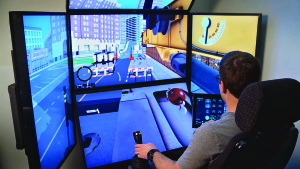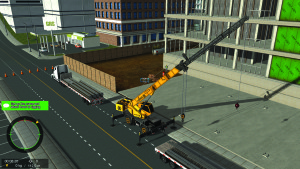Study Seeks to Determine the Value of Simulators in Crane Training

View from the operator’s seat. Operators with all levels of experience will be trained using a Vortex Rough Terrain Mobile Crane Training Module.
Crane Industry Services LLC (CIS) announces a skills assessment study being conducted by CIS in conjunction with CM Labs Simulations Inc., Montreal, Quebec, and West Georgia Technical College. The study’s purpose is to determine what operational skill level can be achieved with the use of crane simulators. The study commenced in July and will continue for 14 months and/or after 500 operators have participated in the research.
“This study is a first for the crane industry,” said Debbie Dickinson, CEO of Crane Industry Services. “While crane simulation tools are not new to the construction industry, there is little quantitative research that determines the value crane simulation offers as part of comprehensive training. We anticipate that the validated study will be used to set specific goals for skill development.” Crane Industry Services is familiar with blended-learning. It currently combines online introductory training, instructor-led classroom training, hands-on instruction, and on-the-job training. CIS leaders were among the first in the industry to create interactive and broadcast quality video learning for the industry.

Typical graphic display from a training module to be used as part of the study being conducted by Crane Industry Services LLC, CM Labs Simulations Inc., and West Georgia Technical College.
“The addition of crane simulators into our curriculum is a natural fit and the industry welcomes this use of technology,” said Cliff Dickinson, President of CIS.
“We are extremely pleased to participate in this study,” says Drew Carruthers, CM Labs’ Construction Product Manager. “It benefits the industry as a whole to understand how we can use simulator-based training to accelerate construction training programs.” CM Labs is the developer of Vortex training simulators.
Scope and objectives
Among the objectives of the study are to:
- Determine what skills can be achieved when simulators are used as part of training.
- Yield a comparative study of the time required for operators to reach certain skill levels.
- Estimate the level of proficiency that can be obtained using concentrated learning and practice.
- Test performance evaluation options.
- Train entry level operators safely.
- Refresh experienced operator skills and practice new equipment or lift conditions.
The population to be studied includes inexperienced, moderately experienced, and very experienced operators, who will be trained using a Vortex Rough Terrain Mobile Crane Training Module. The research partners are seeking employers with operators who 1) have no real experience (less than 99 hours operating time total) and who’ve only had classroom instruction on crane safety concepts; 2) have limited experience (up to 1,000 hours operating time in the previous five year period), but whose crane operation exposure is no more than 20% of their on-the-job time per year. These operators may come from general industry or construction, and they may or may not be certified; and 3) are considered full-time crane operators (over 1,000 hours operating time in the previous five year period), but who have had little or no exposure to training simulators. In most cases, these will be certified crane operators.
Powered by the Vortex Simulation Software engine, the device simulates multi-body dynamics and captures real behavior of cranes, rigging, and loads. Simulations are based on actual crane models with real controls and functionality. The Vortex Training Module is based on a 40-ton rough-terrain crane with a full boom extension of 102 feet. Among its features is the ability for the operator to configure the LMI and set alarms and change the number of parts of line. See an example of the training module in action
“We hope this research will be used to set industry standards for simulation training and to assist employers in measuring the value of simulation as part of training,” said Dickinson. For information on participating in the study, call 770.783.9292 or email info@CenteredonSafety.com.
